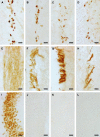Absent or low rate of adult neurogenesis in the hippocampus of bats (Chiroptera)
- PMID: 17520014
- PMCID: PMC1866182
- DOI: 10.1371/journal.pone.0000455
Absent or low rate of adult neurogenesis in the hippocampus of bats (Chiroptera)
Abstract
Bats are the only flying mammals and have well developed navigation abilities for 3D-space. Even bats with comparatively small home ranges cover much larger territories than rodents, and long-distance migration by some species is unique among small mammals. Adult proliferation of neurons, i.e., adult neurogenesis, in the dentate gyrus of rodents is thought to play an important role in spatial memory and learning, as indicated by lesion studies and recordings of neurons active during spatial behavior. Assuming a role of adult neurogenesis in hippocampal function, one might expect high levels of adult neurogenesis in bats, particularly among fruit- and nectar-eating bats in need of excellent spatial working memory. The dentate gyrus of 12 tropical bat species was examined immunohistochemically, using multiple antibodies against proteins specific for proliferating cells (Ki-67, MCM2), and migrating and differentiating neurons (Doublecortin, NeuroD). Our data show a complete lack of hippocampal neurogenesis in nine of the species (Glossophaga soricina, Carollia perspicillata, Phyllostomus discolor, Nycteris macrotis, Nycteris thebaica, Hipposideros cyclops, Neoromicia rendalli, Pipistrellus guineensis, and Scotophilus leucogaster), while it was present at low levels in three species (Chaerephon pumila, Mops condylurus and Hipposideros caffer). Although not all antigens were recognized in all species, proliferation activity in the subventricular zone and rostral migratory stream was found in all species, confirming the appropriateness of our methods for detecting neurogenesis. The small variation of adult hippocampal neurogenesis within our sample of bats showed no indication of a correlation with phylogenetic relationship, foraging strategy, type of hunting habitat or diet. Our data indicate that the widely accepted notion of adult neurogenesis supporting spatial abilities needs to be considered carefully. Given their astonishing longevity, certain bat species may be useful subjects to compare adult neurogenesis with other long-living species, such as monkeys and humans, showing low rates of adult hippocampal neurogenesis.
Conflict of interest statement
Figures




References
-
- Fleming TH, Eby P. Ecology of bat migration. In: Kunz TH, Fenton MB, editors. Bat ecology. ChicagoLondon: University of Chicago Press; 2003. pp. 156–208.
-
- Wilson MA, McNaughton BL. Dynamics of the hippocampal ensemble code for space. Science. 1993;261:1055–1058. - PubMed
-
- Ulanovsky N, Moss CF. Hippocampal cellular and network activity in freely moving echolocating bats. Nature Neurosci. 2007;10:224–233. - PubMed
-
- Baron G, Stephan H, Frahm HD. Comparative Neurobiology in Chiroptera: Macromorphology, brain structures, tables and atlases. Basel: Birkhäuser Verlag; 1996.
Publication types
MeSH terms
LinkOut - more resources
Full Text Sources
Miscellaneous

